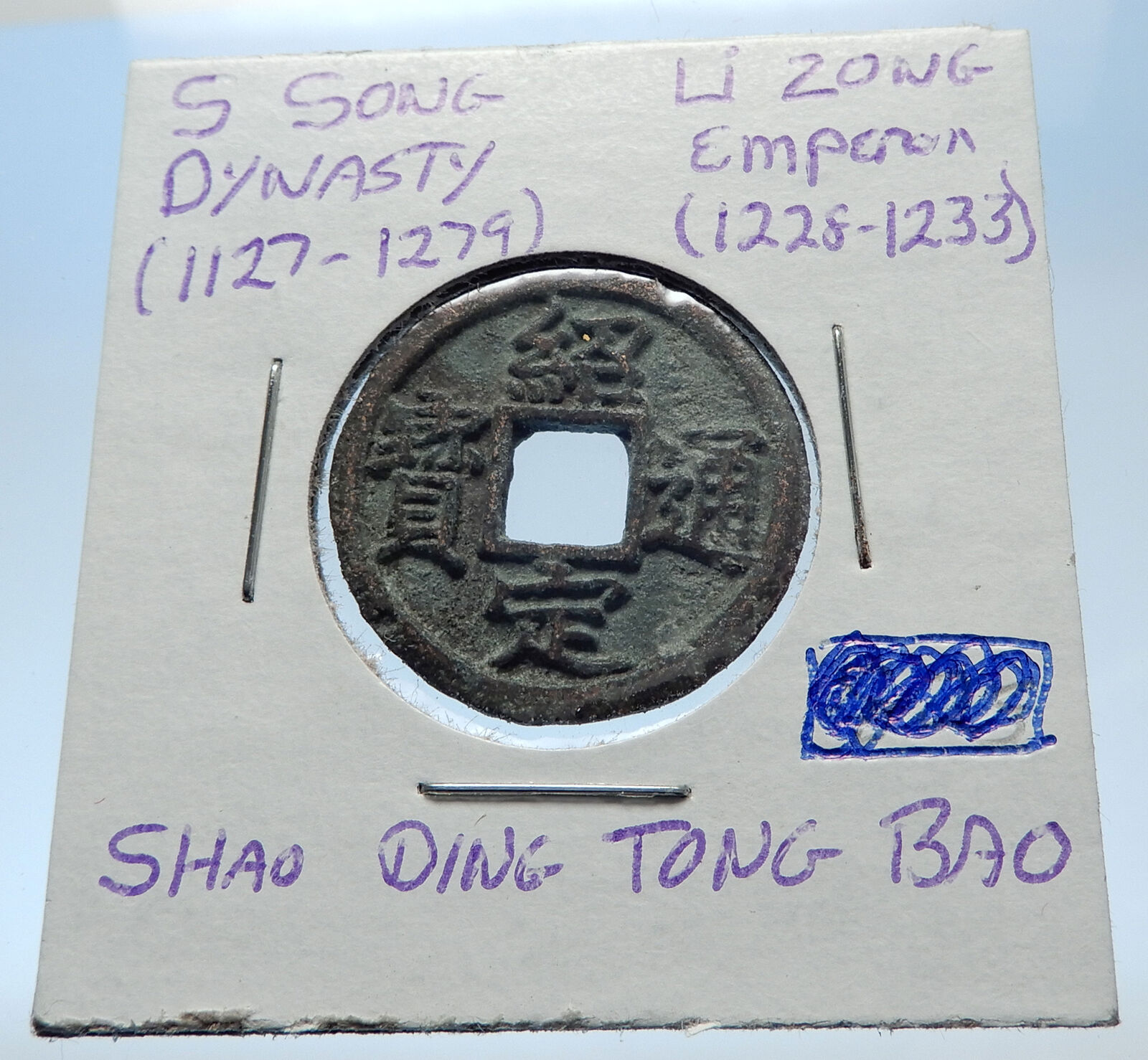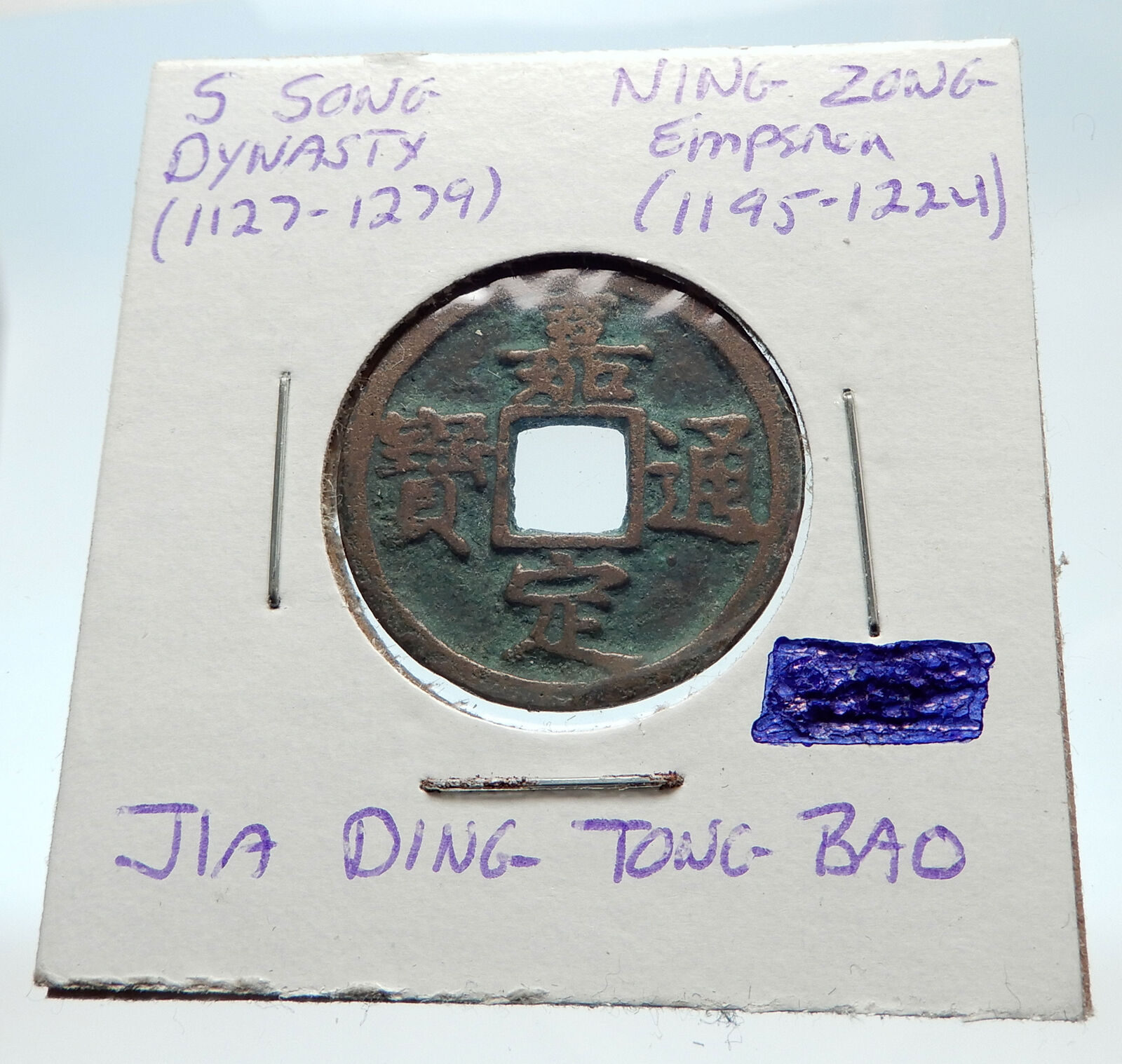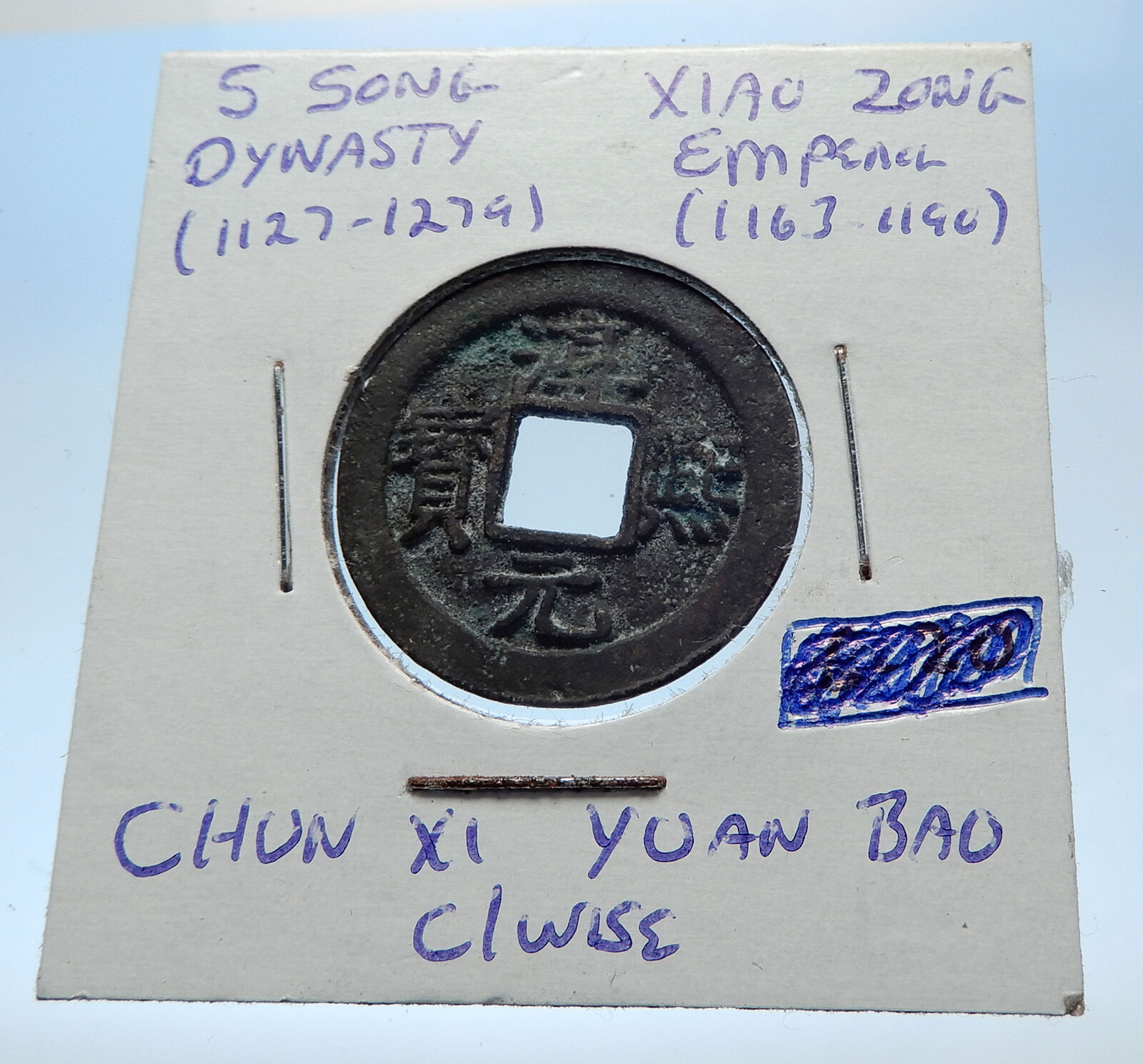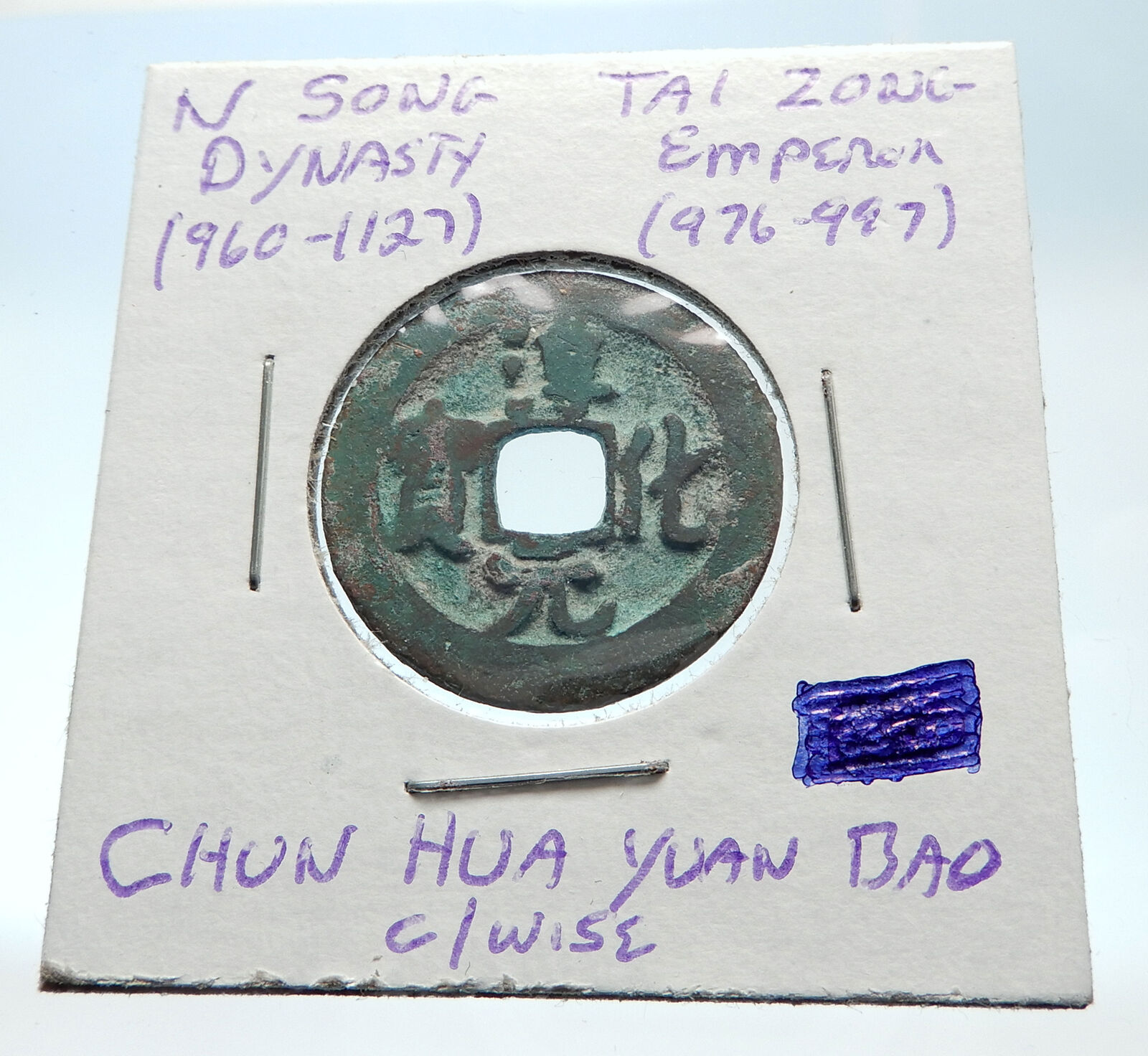|
China –
Southern Han Kingdom (905-971 AD)
Emperor Liu Yan (Lie Zu) (917-942 AD)
Lead Qian Heng Zong Bao
Cash Token 24mm, Struck 917-942 AD
Reference: H# 15.108
Chinese Symbols.
You are bidding on the exact item pictured, provided with a Certificate of Authenticity and Lifetime Guarantee of Authenticity.
Liu Yan (劉 龑; 刘 䶮; Liú Yǎn; 889 – 10 June 942), né Liu Yan (劉巖), also known as Liu Zhi (劉陟) (from c. 896 to 911) and briefly as Liu Gong (劉龔), formally Tianhuang Dadi (天皇大帝) with the temple name Gaozu (高祖), was the first emperor of the Chinese Five Dynasties and Ten Kingdoms period state Southern Han.
In 919, Liu Yan created his wife Lady Ma empress.
In 920, at Yang Dongqian’s request, Liu Yan established schools and imperial examinations, apparently following the Tang model. He also sent emissaries to Former Shu, seeking friendly relations.
In 922, there was an incident where Liu Yan, believing in the words of a sorcerer that he needed to leave the capital to avoid a disaster, left Xingwang to visit Meikou (梅口, in modern Meizhou, Guangdong), near the Min border. The Min general Wang Yanmei (Wang Shenzhi’s son or nephew) decided to launch a surprise attack on Liu Yan’s train, but before Wang Yanmei’s forces arrived, Liu Yan received the news and fled Meikou before Min forces could attack.
In 924, Liu Yan launched an attack on Min, advancing on the borders of Min’s Ting (汀洲, in modern Longyan, Fujian) and Zhang (漳州, in modern Zhangzhou, Fujian) Prefectures. A Min counterattack defeated him, and he fled.
Meanwhile, in 923, Later Liang had been conquered by its northern rival Jin, whose prince Li Cunxu declared himself the emperor of a new Later Tang (as Emperor Zhuangzong). When the news reached Liu Yan, Liu Yan became fearful of this powerful new state in the north, and in 925 sent his official He Ci (何詞) to Later Tang to try to seek friendly relations in humble terms (referring to himself as “the King of the Great Han” rather than emperor while addressing Emperor Zhuangzong as “the Emperor of the Great Tang”) and to find out more about the strength of this new dynasty. After He Ci returned, He Ci reported that Emperor Zhuangzong had become arrogant and excessive and that there was no need to be fearful of him; Liu Yan was pleased, and from this point on no longer sought communications with Later Tang.
Later in the year, it was said that a white dragon was discovered in the Han palace. In response, Liu Yan changed his era name to Bailong (“white dragon”) and changed his own name to Gong (龔). However, later in the year, when foreign monks informed him that the character “Gong” was not favorable to Southern Han’s fortune, he further changed his name to a newly created character (龑), showing the character of a dragon (龍) over that of heaven (天), pronouncing the newly created character “Yan.” (The Zizhi Tongjian placed this second name change in 941. Also in 925, when Zheng Min (鄭旻) the emperor of Changhe, sent his brother Zheng Zhaochun (鄭昭淳) to Southern Han to seek a marriage alliance, Liu Yan gave another niece, the Princess Zengcheng, to Zheng Min in marriage. 18]
Middle reign
In 928, a Chu fleet attacked Southern Han and put Feng Prefecture under siege. In response, Liu Yan, believing that Dayou was a phrase from the I Ching that would portend good fortune in battle, changed the era name to Dayou, and also sent the general Su Zhang (蘇章) to take a fleet manned with well-trained archers to try to lift the siege on Feng. Su engaged the Chu fleet and pretended to withdraw after a skirmish, inducing the Chu fleet to chase; he then caught the Chu fleet in an ambush and defeated it, forcing the Chu forces to withdraw.
In 930, Liu Yan sent his generals Liang Kezhen (梁克貞) and Li Shoufu (李守鄜) to attack Jiao Prefecture; they captured it and took Khuc Thua My (曲承美, son and successor of Khuc Hao) captive, taking (for the time being) Jinghai Circuit (靜海, Vietnamese: Tĩnh Hải, headquartered at Jiao Prefecture) under Southern Han control and ending the control of the circuit by the Khúc family. Liang further advanced to Champa and pillaged it of its treasure. Liu stationed his general Li Jin (李進) at Jiao Prefecture to defend it.
The Southern Han hold on Jinghai would not last long, however. After the fall of the Khúcs, Dương Đình Nghệ the prefect of Ai Prefecture (愛州, Vietnamese: Ai châu, in modern Thanh Hóa Province, Vietnam) built up a personal army of 3,000 adoptive sons, wanting to take control of Jinghai. Although Li knew about this, he did nothing as he was receiving regular bribes from Dương. In 931, Duong put Jiao Prefecture under siege. Liu Yan sent the general Cheng Bao (程寶) to try to lift the siege, but before Cheng could get there, the city fell. Li fled back to Xingwang, where Liu put him to death. Cheng tried to recapture Jiao Prefecture, but Yang defeated and killed him in battle.
In 932, Liu Yan created his 19 sons as imperial princes.
In 934, Empress Ma died.
Also in 934, Liu Yan allowed his then-surviving oldest son Liu Hongdu the Prince of Qin (Liu Hongdu’s older brothers Liu Yaoshu and Liu Guitu having died earlier) to form a guard force of his own, but these guard ranks were filled with hoodlums that Liu Hongdu was close to. When Yang Dongqian tried to speak on this matter to advise Liu Yan to curb Liu Hongdu’s activities, as Liu Hongdu was commonly regarded as the heir, Liu Yan refused to listen. When Yang subsequently observed the guards pillage gold and silk from merchants and the merchants’ fear causing them not to report the matter, Yang lamented, “If the rule is as troubled as this, what is a chancellor for?” He thus claimed an illness and retired to his mansion. Liu Yan subsequently never against summoned Yang for any audiences, and Yang eventually died at his home without returning to chancellorship.
Late reign
In 936, Liu Yan sent his general Sun Dewei (孫德威) to attack Chu’s Meng (蒙州, in modern Wuzhou, Guangxi) and Gui (桂州, in modern Guilin, Guangxi). When Chu’s prince Ma Xifan (Ma Yin’s son) personally went to Gui Prefecture to defend against the attack, Sun withdrew.
In 937, Dương Đình Nghệ was killed by his general Kiều Công Tiễn (矯公羨), who took over Jinghai. In 938, when another former general of Duong’s, Ngô Quyền (吳權), rose at Ai Prefecture and subsequently attacked Jiao Prefecture, Kieu Cong Tien sought aid from Southern Han. Liu Yan wanted to use this opportunity to take over Jinghai again, so he commissioned his son Liu Hongcao as the military governor of Jinghai and changed his title to Prince of Jiao, having him command an army to head to Jiao Prefecture while Liu Yan himself commanded a follow-up army. By the time that Liu Hongcao was approaching Jiao Prefecture, however, Wu had already defeated and killed Kieu Cong Tien and occupied Jiao Prefecture. When Liu Hongcao prepared to attack, Wu set a trap for him—setting large wooden planks covered with iron into the tidal zone, such that when Liu Hongcao attacked at high tide, the planks were invisible, but when the tide fell, the Southern Han ships became stuck on the planks and unable to move. Ngo then counterattacked, killing more than half of the Southern Han soldiers, including Liu Hongcao. Liu Yan, hearing the news, cried bitterly and withdrew his own fleet. (This became known as the Battle of Bạch Đằng River.)
In 939, Zhao Guangyi, pointing out that there had not been any emissaries sent between Southern Han and Chu after Empress Ma’s death and that the two states, related by marriage, should be friendly to each other, recommended the official Li Shu (李紓) as an appropriate emissary. Liu Yan agreed, and after Li visited Chu, Chu also sent emissaries to Southern Han, reestablishing relations between the two states. Despite this, in 941, Liu Yan sent an emissary to Later Jin’s Emperor Gaozu (whose Later Jin state had earlier taken over Later Tang’s territory) seeking a military alliance where they would attack Chu and divide its territory; the Later Jin emperor declined.
In 942, Liu Yan grew seriously ill. He considered both of his oldest surviving sons, Liu Hongdu and Liu Hongxi the Prince of Jin, to be arrogant and unrestrained, and considered a younger son, Liu Hongchang the Prince of Yue, to be an appropriate successor. He thus considered sending Liu Hongdu and Liu Hongxi out of the capital and making Liu Hongchang his heir. However, the official Xiao Yi (蕭益) persuaded him that bypassing older sons would cause disturbances, and so Liu Yan did not carry out this plan. He soon died, and Liu Hongdu became emperor (as Emperor Shang).
The Zizhi Tongjian, summarizing the opinions from other sources, commented about Liu Yan’s reign:
Gaozu .e., Liu Yan)] was observant and capable of political tactics, but was self-important, often referring to the emperors of the Central Plain as “prefect of Luo Prefecture” .e., Luoyang, which often served as the capital of Five Dynasties states)]. The Lingnan region was where rare jewels could be gathered, so he was luxurious in his living and favored beautiful things, adorning his palaces with gold, jades, and pearls. He was cruel in his punishments, using methods including cutting off noses, cutting off tongues, dismemberment, cutting pregnant women open, tying people to heated iron poles, and boiling people. He also sometimes put poisonous snakes in the water and threw criminals into the water, referring to this as “water prison.” When the chancellor Yang Dongqian tried to correct his ways, he would not listen to Yang. In his late years, he was particularly suspicious of the intelligentsia, believing that the officials would be more concerned about the welfare of their descendants rather than of the state, and therefore became trusting of eunuchs. Therefore, from this point on, Southern Han had many eunuchs.
 Southern Han (Chinese: 南漢; pinyin: Nán Hàn; 917–971), officially Han (Chinese: 漢), originally Yue (Chinese: 越), was one of the ten kingdoms that existed during the Five Dynasties and Ten Kingdoms period. It was located on China’s southern coast, controlling modern Guangdong and Guangxi. The kingdom greatly expanded its capital Xingwang Fu (Chinese: 興王府; pinyin: Xìngwáng Fǔ, present-day Guangzhou). It attempted but failed to annex the independent polity of Jinghai which was controlled by the Vietnamese. Southern Han (Chinese: 南漢; pinyin: Nán Hàn; 917–971), officially Han (Chinese: 漢), originally Yue (Chinese: 越), was one of the ten kingdoms that existed during the Five Dynasties and Ten Kingdoms period. It was located on China’s southern coast, controlling modern Guangdong and Guangxi. The kingdom greatly expanded its capital Xingwang Fu (Chinese: 興王府; pinyin: Xìngwáng Fǔ, present-day Guangzhou). It attempted but failed to annex the independent polity of Jinghai which was controlled by the Vietnamese.
Liu Yin was named regional governor and military officer by the Tang court in 905. Though the Tang fell two years later, Liu did not declare himself the founder of a new kingdom as other southern leaders had done. He merely inherited the title of Prince of Nanping in 909.
It was not until Liu Yin’s death in 917 that his brother, Liu Yan, declared the founding of a new kingdom, which he initially called “Yue” (越); he changed the name to Han (漢) in 918. This was because his surname Liu (劉) was the imperial surname of the Han dynasty and he claimed to be a descendant of that famous dynasty. The kingdom is often referred to as the Southern Han Dynasty throughout China’s history. It attempted but failed to annex the independent polity of Jinghai which was controlled by the Vietnamese.
With its capital at present-day Guangzhou, the domains of the kingdom spread along the coastal regions of present-day Guangdong, Guangxi and the island of Hainan. It had borders with the kingdoms of Min, Chu and the Southern Tang as well as the non-Chinese kingdoms of Dali. The Southern Tang occupied all of the northern boundary of the Southern Han after Min and Chu were conquered by the Southern Tang in 945 and 951 respectively.
 During the late 9th century as the Tang dynasty weakened, local Vietnamese lords began taking control of its domain in Jinghai (northern Vietnam). Southern Han campaigned twice against the Vietnamese in 931 and 938 in an attempt to add these Vietnamese territories to their realm, but failed both. During the late 9th century as the Tang dynasty weakened, local Vietnamese lords began taking control of its domain in Jinghai (northern Vietnam). Southern Han campaigned twice against the Vietnamese in 931 and 938 in an attempt to add these Vietnamese territories to their realm, but failed both.
The Five Dynasties ended in 960 when the Song Dynasty was founded to replace the Later Zhou. From that point, the new Song rulers set themselves about to continue the reunification process set in motion by the Later Zhou. Through the 960s and 970s, the Song increased its influence in the south until finally it was able to force the Southern Han dynasty to submit to its rule in 971.
Cash was a type of coin of China and East Asia, used from the 4th century BC until the 20th century AD. Originally cast during the Warring States period, these coins continued to be used for the entirety of Imperial China as well as under Mongol, and Manchu rule. The last Chinese cash coins were cast in the first year of the Republic of China. Generally most cash coins were made from copper or bronze alloys, with iron, lead, and zinc coins occasionally used less often throughout Chinese history. Rare silver and gold cash coins were also produced. During most of their production, cash coins were cast but, during the late Qing dynasty, machine-struck cash coins began to be made. As the cash coins produced over Chinese history were similar, thousand year old cash coins produced during the Northern Song dynasty continued to circulate as valid currency well into the early twentieth century.
In the modern era, these coins are considered to be Chinese “good luck coins”; they are hung on strings and round the necks of children, or over the beds of sick people. They hold a place in various superstitions, as well as Traditional Chinese medicine, and Feng shui. Currencies based on the Chinese cash coins include the Japanese mon, Korean mun, Ryukyuan mon, and Vietnamese văn.
|






 Southern Han (Chinese: 南漢; pinyin: Nán Hàn; 917–971), officially Han (Chinese: 漢), originally Yue (Chinese: 越), was one of the ten kingdoms that existed during the Five Dynasties and Ten Kingdoms period. It was located on China’s southern coast, controlling modern Guangdong and Guangxi. The kingdom greatly expanded its capital Xingwang Fu (Chinese: 興王府; pinyin: Xìngwáng Fǔ, present-day Guangzhou). It attempted but failed to annex the independent polity of Jinghai which was controlled by the Vietnamese.
Southern Han (Chinese: 南漢; pinyin: Nán Hàn; 917–971), officially Han (Chinese: 漢), originally Yue (Chinese: 越), was one of the ten kingdoms that existed during the Five Dynasties and Ten Kingdoms period. It was located on China’s southern coast, controlling modern Guangdong and Guangxi. The kingdom greatly expanded its capital Xingwang Fu (Chinese: 興王府; pinyin: Xìngwáng Fǔ, present-day Guangzhou). It attempted but failed to annex the independent polity of Jinghai which was controlled by the Vietnamese. During the late 9th century as the Tang dynasty weakened, local Vietnamese lords began taking control of its domain in Jinghai (northern Vietnam). Southern Han campaigned twice against the Vietnamese in 931 and 938 in an attempt to add these Vietnamese territories to their realm, but failed both.
During the late 9th century as the Tang dynasty weakened, local Vietnamese lords began taking control of its domain in Jinghai (northern Vietnam). Southern Han campaigned twice against the Vietnamese in 931 and 938 in an attempt to add these Vietnamese territories to their realm, but failed both.



